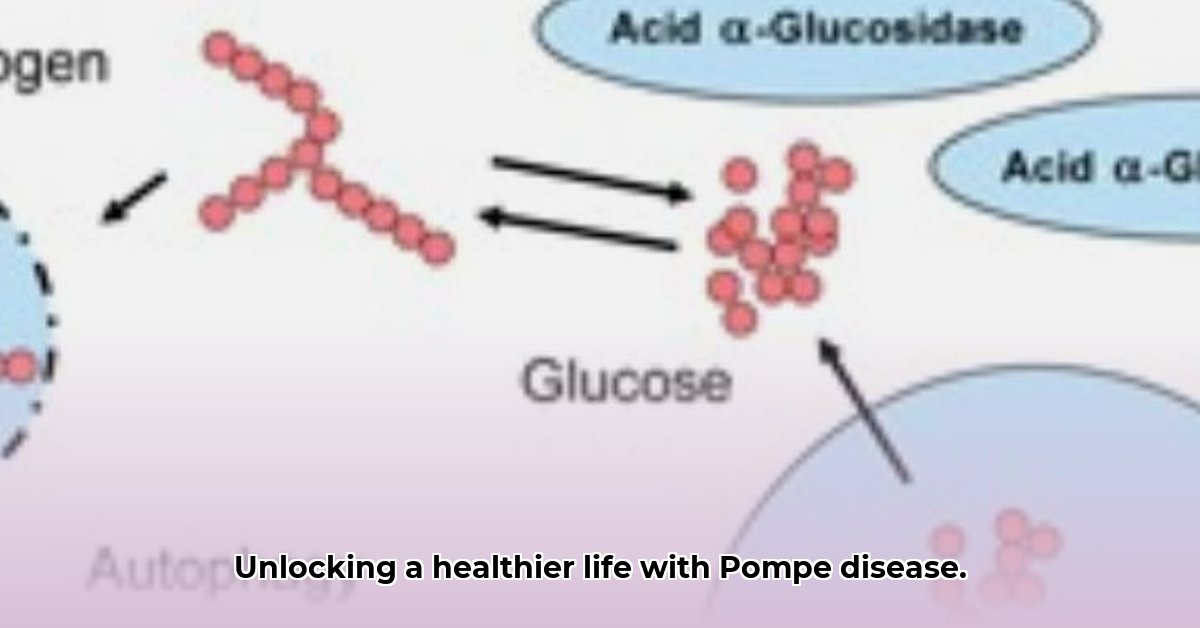
What is Pompe Disease?
Pompe disease (also known as Ziekte Pompe in Afrikaans) is a rare genetic disorder. Think of your body's cells as tiny power stations constantly working. In Pompe disease, these power stations struggle to break down glycogen (a type of stored energy) because of a missing or faulty GAA gene. This gene provides instructions for making an enzyme (alpha-glucosidase) essential for glycogen breakdown. Without this enzyme, glycogen accumulates inside the cells, causing damage, particularly impacting muscles, the heart, and the lungs. (This accumulation leads to muscle weakness, respiratory problems, and potential heart complications)
Types and Onset of Pompe Disease
Pompe disease doesn't affect everyone the same way. The age of onset significantly influences the severity and symptoms:
- Infantile-onset Pompe disease: Symptoms appear in infancy, often causing severe breathing and heart problems early. This is the most severe form.
- Late-onset Pompe disease: Symptoms develop later in childhood, adolescence, or adulthood, with varying severity. Individuals might experience milder muscle weakness and fatigue initially.
While the prevalence of each type in South Africa isn't precisely known, it's vital to understand that early diagnosis is much better for the long-term prognosis.
Diagnosis of Pompe Disease
Diagnosing Pompe disease involves several steps:
- Elevated Creatine Kinase (CK) levels: A blood test checks for elevated CK, indicating potential muscle damage. (High CK levels signal muscle damage and suggest the possibility of Pompe disease.)
- Genetic testing: This test directly examines the GAA gene to identify any mutations or deficiencies. (This confirms the genetic basis of the disease)
- Muscle biopsy (if necessary): A small muscle sample is examined under a microscope to assess glycogen accumulation within muscle cells. (This provides direct visual evidence of glycogen build-up)
Early diagnosis is crucial for effective management and improving long-term outcomes.
Treatment of Pompe Disease
The primary treatment for Pompe disease is Enzyme Replacement Therapy (ERT). ERT involves regular intravenous infusions (IV drips) of the missing enzyme, helping to break down the accumulated glycogen. (ERT helps to alleviate symptoms and improve quality of life.) However, ERT is a management tool, not a cure, and lifelong treatment is usually required.
Managing Symptoms: Treatment goes beyond ERT alone. A multidisciplinary team, including physicians, physiotherapists and respiratory therapists, should manage the condition's impact. They work collaboratively to address various symptoms – from muscle weakness to respiratory issues. (This approach addresses the various complications and supports the patient through treatment.)
Potential Complications: Although rare, malignant hyperthermia (a severe reaction to certain anesthetics) is a potential risk; precautions are necessary during procedures involving anesthesia. (Pre-operative discussions with anesthetists are of crucial importance). Ongoing research continues to explore new and more effective therapies.
Living with Pompe Disease
Living well with Pompe disease is achievable with proactive management. This includes:
- Daily life management: Tailored exercise programs (strength and endurance training for suitable individuals), a balanced diet, and respiratory support (if needed) are key.
- Emotional and psychological support: Support groups and counseling offer vital outlets for patients and families to enhance well-being and coping mechanisms. Support networks are essential.
- Long-term prognosis and care: The prognosis varies significantly depending on the onset age and response to treatment. Ongoing monitoring and management from a multidisciplinary healthcare team are essential. (Regular checkups and proactive care ensures the best possible outcome).
Resources and Support
Several organizations provide invaluable support and resources for individuals with Pompe disease and their families. These include patient advocacy groups, research initiatives, and genetic counseling services. Your healthcare provider can assist you in locating appropriate resources and support services tailored to your needs. (Early access to therapies and support networks greatly improves the quality of life for patients).
Managing Risks Associated with Pompe Disease and ERT
Careful management of risks is crucial. These include side effects from ERT (allergic reactions, etc), which can range from mild to more serious, and malignant hyperthermia, a rare but severe reaction to certain anesthetics. Regular monitoring, careful anesthetic selection, and open communication with your healthcare team are essential for minimizing these risks and optimising outcomes.
Remember, living a fulfilling life with Pompe disease is possible. With the right support, proactive management, and a positive outlook, you can effectively manage this condition and maintain a high quality of life.